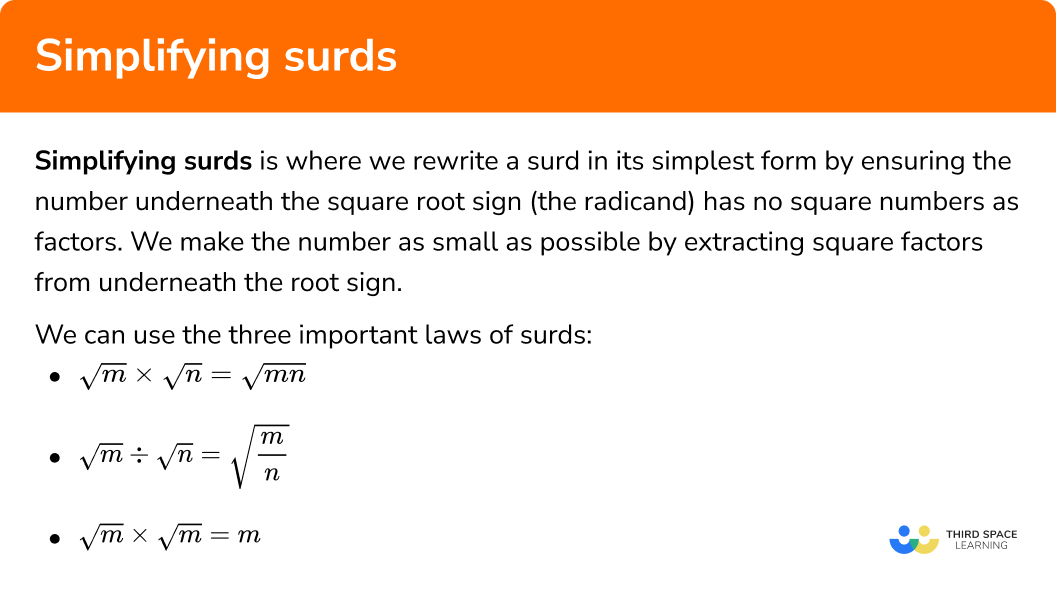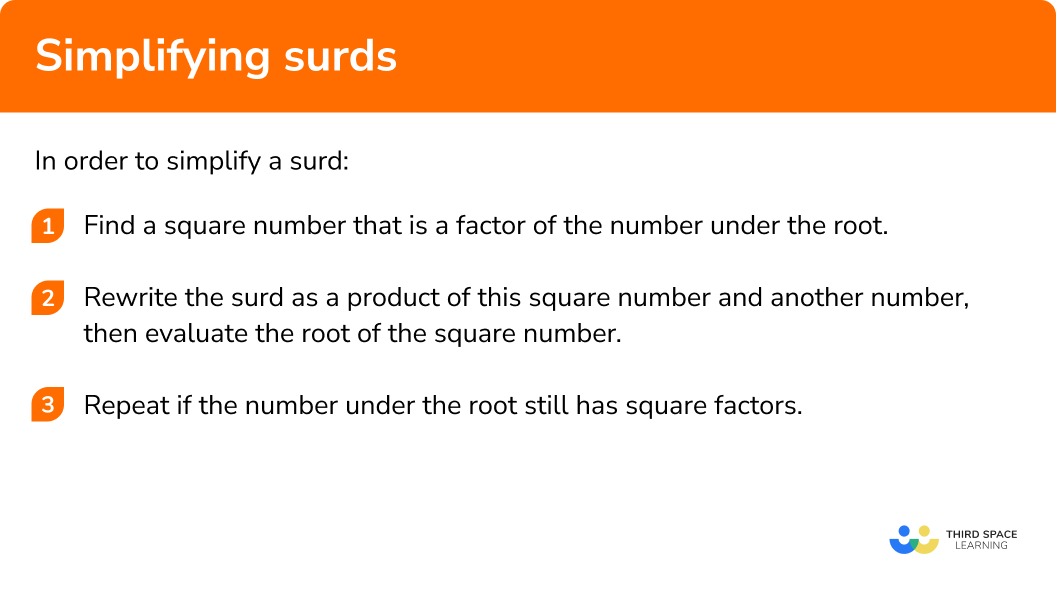GCSE Tutoring Programme
"Our chosen students improved 1.19 of a grade on average - 0.45 more than those who didn't have the tutoring."
This topic is relevant for:

Simplifying Surds
Here we will learn about simplifying surds for GCSE maths including the definition of a surd, the rules of surds, and how to write surds in their simplest form.
There are also simplifying surds worksheets based on Edexcel, AQA and OCR exam questions, along with further guidance on where to go next if you’re still stuck.
What is simplifying surds?
Simplifying surds is where we rewrite a surd in its simplest form by ensuring the number underneath the root sign (this number is called the radicand) has no square numbers as factors. We make the number as small as possible by extracting square factors from underneath the root sign.
We can use the three important laws of surds, which can be derived from the laws of indices (powers) to help us to simplify surds:
E.g.
What is simplifying surds?

How to simplify surds
In order to simplify a surd:
- Find a square number that is a factor of the number under the root.
- Rewrite the surd as a product of this square number and another number, then evaluate the root of the square number.
- Repeat if the number under the root still has square factors.
How to simplify surds


Simplifying surds worksheet

Get your free simplifying surds worksheet of 20+ questions and answers. Includes reasoning and applied questions on how to simplify surds.
DOWNLOAD FREE
Simplifying surds worksheet

Get your free simplifying surds worksheet of 20+ questions and answers. Includes reasoning and applied questions on how to simplify surds.
DOWNLOAD FREESimplifying surds examples
Example 1: A simple integer
Simplify:
- Find a square number that is a factor of the number under the root.
Square numbers are
2Rewrite the surd as a product of this square number and another number, then evaluate the root of the square number.
3Repeat if the number under the root still has square factors.
In this case, there are no square numbers that are factors of
Example 2: A simple integer
Simplify:
Find a square number that is a factor of the number under the root.
Square numbers are
Rewrite the surd as a product of this square number and another number, then evaluate the root of the square number.
Repeat if the number under the root still has square factors.
In this case, there are no square numbers that are factors of
Example 3: A larger integer
Simplify:
Find a square number that is a factor of the number under the root.
Square numbers are
Rewrite the surd as a product of this square number and another number, then evaluate the root of the square number.
Repeat if the number under the root still has square factors.
In this case,
There are no square numbers that are factors of
To finish off, work out the product of the integers in front of the root (
The final answer, in its simplest form, is
Note that you could have completed this simplification in one step by spotting that
This method is clearly more efficient, but it’s not always easy to spot large square factors; in this case, you will probably find it easier to work in stages.
Example 4: A larger integer
Simplify:
Find a square number that is a factor of the number under the root.
Square numbers are
Rewrite the surd as a product of this square number and another number, then evaluate the root of the square number.
Repeat if the number under the root still has square factors.
In this case,
There are no square numbers that are factors of
To finish off, work out the product of the integers in front of the root (
The final answer in its simplest form is
Example 5: Strategies for very large integers
Simplify:
Find a square number that is a factor of the number under the root.
Rewrite the surd as a product of this square number and another number, then evaluate the root of the square number.
Repeat if the number under the root still has square factors.
In this case,
There are no square numbers that are factors of
To finish off, work out the product of the integers in front of the root (
The final answer in its simplest form is
The prime factor tree method for larger numbers
This is an alternative method for simplifying surds that is very effective for larger numbers. It is similar to, and based on, prime factor trees.
Find any factor pair of the radicand – like a prime factor tree.
Continue like a prime factor tree, until the numbers under the square root signs are either primes or squares.
(Note that we could also stop at
Beginning with the square numbers, write out as a product as you would with a prime factor tree. Then simplify the answer.
Square root both the
Finally,
Example 6: A partially simplified surd expression
Simplify:
Remember that this means
Or
So all we need to do is deal with the root
Find a square number that is a factor of the number under the root.
Rewrite the surd as a product of this square number and another number, then evaluate the root of the square number.
Repeat if the number under the root still has square factors.
In this case, there are no square numbers that are factors of
Common misconceptions
- Incorrectly rewriting the number under the square root sign (the radicand) as a product of any two factors
One of these factors must be a square number in order for you to be able to simplify the surd.
- Not simplifying fully
Always check that there are no square factors of the number under the root.
Related lessons
Simplifying surds is part of our series of lessons to support revision on surds. You may find it helpful to start with the main surds lesson for a summary of what to expect, or use the step by step guides below for further detail on individual topics. Other lessons in this series include:
Practice simplifying surds questions
1. Simplify: \sqrt{9}




The square root of 9 is 3 (this is a rational number, so the square root of 9 is not a surd).
2. Simplify: \sqrt{20}




4 is the largest square factor of 20, (4\times5=20) . The square root of 4 is 2 .
3. Simplify: \sqrt{15}




There are no square numbers that are factors of 15 , so this surd is already simplified as far as possible.
4. Simplify: \sqrt{150}




25 is the largest square factor of 150, (25\times6=150) . The square root of 25 is 5 .
5. Simplify: \sqrt{368}




16 is the largest square factor of 368, (16\times23=368) . The square root of 16 is 4 .
6. Simplify: 3\sqrt{280}




4 is the largest square factor of 280, (4\times70=280) . The square root of 4 is 2 , so \sqrt{280}=2 \sqrt{70} . Finally, multiply by the 3 to get 6\sqrt{70} .
Simplifying surds GCSE questions
1. Simplify
\sqrt{84}
(2 marks)
(1)
2 \sqrt{21}Correct answer
(1)
2. Simplify fully
\sqrt{540}
(2 marks)
(1)
6 \sqrt{15}
Correct answer
(1)
3. \sqrt{912}=4\sqrt{k}
where k is an integer. Find the value of k .
(2 marks)
\sqrt{912}=\sqrt{16}\times \sqrt{k}
or sight of 912\div16
(1)
4 \sqrt{57}
so k=57
(1)
4. Simplify fully
5 \sqrt{80}
(2 marks)
(1)
20\sqrt{5}
Correct answer
(1)
Learning checklist
You have now learned how to:
-
Identify a surd as an irrational root
-
Simplify surds
Still stuck?
Prepare your KS4 students for maths GCSEs success with Third Space Learning. Weekly online one to one GCSE maths revision lessons delivered by expert maths tutors.

Find out more about our GCSE maths tuition programme.